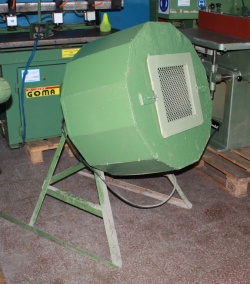Concrete mixer in woodworkin?
Yes why not ?
This is my small concrete mixer. Its not profesional machine for wood finish. Profesional machines have diferent shape and additions : vacum, heating etc.
![Image]()
![Image]()
This method is use to paint large quantities of small items and sand it.
For mass prodduction wood turning items you need special automatic lathe.
In the hobby shop nobody have one.
But using router and bench saws You can make thousands of small parts.
![Image]()
In movie I used old bead the have 2-3 years and I found it yesterday.
Methot :
1. Put new made items in chamber and roll it for few hours. Time and adding sanding fillers depend on items size and shape.
2. Clean from dust and trash.
3. Now Is two way to finish : using water stain and transparent lacquer or colored lacquer.
Varnishes are specialized, two-component chemically curing > lacquer and catalyst
In water stain method for first layer is cheaper to usche cheap lacquer for example nitro. Wood for first layer soak lot of lacquer and niro catalyst in 1 hour. Specialized lacquer must cured in 24h. So in one day you put 2 layers cheap lacquer and catalyst lacquer.
Beads are remove from mixer almost immediately when You see that lacquer layer is even. Put on frame with net. Time to time mix for prevent sticking together.
After painting the grain stand up on the wood. So in first 2-3 layers after curing you put beads in machine and roll for 30m to 1h.
That sand out imperfections.
4.Now every 24 hours.
You put beads into the mixer, paint it.
You put it on the net and are watching not to get stick together.
Until the required shine. It takes up to several days.
It is important to paint a thin layer of lacquer and thoroughly. Lots of thin layers is the key to success.
It is important: the density of the paint, the amount of paint, the shape of objects, rolling time, humidity.
Well dry in the open air on a sunny day.
Not too much sun at the first layers. Wood drying and released from its air and water vapor. This causes creation of bubbles on the surface.
Effects
![Image]()
![Image]()
![Image]()
![Image]()
![Image]()
Album > https://plus.google.com/photos/111906254492164471907/albums/5564400046909467537
Movies from YT
https://youtu.be/7OLIgs20LQQ?t=2m9s
Yes why not ?
This is my small concrete mixer. Its not profesional machine for wood finish. Profesional machines have diferent shape and additions : vacum, heating etc.


This method is use to paint large quantities of small items and sand it.
For mass prodduction wood turning items you need special automatic lathe.
In the hobby shop nobody have one.
But using router and bench saws You can make thousands of small parts.

Methot :
1. Put new made items in chamber and roll it for few hours. Time and adding sanding fillers depend on items size and shape.
2. Clean from dust and trash.
3. Now Is two way to finish : using water stain and transparent lacquer or colored lacquer.
Varnishes are specialized, two-component chemically curing > lacquer and catalyst
In water stain method for first layer is cheaper to usche cheap lacquer for example nitro. Wood for first layer soak lot of lacquer and niro catalyst in 1 hour. Specialized lacquer must cured in 24h. So in one day you put 2 layers cheap lacquer and catalyst lacquer.
Beads are remove from mixer almost immediately when You see that lacquer layer is even. Put on frame with net. Time to time mix for prevent sticking together.
After painting the grain stand up on the wood. So in first 2-3 layers after curing you put beads in machine and roll for 30m to 1h.
That sand out imperfections.
4.Now every 24 hours.
You put beads into the mixer, paint it.
You put it on the net and are watching not to get stick together.
Until the required shine. It takes up to several days.
It is important to paint a thin layer of lacquer and thoroughly. Lots of thin layers is the key to success.
It is important: the density of the paint, the amount of paint, the shape of objects, rolling time, humidity.
Well dry in the open air on a sunny day.
Not too much sun at the first layers. Wood drying and released from its air and water vapor. This causes creation of bubbles on the surface.
Effects





Album > https://plus.google.com/photos/111906254492164471907/albums/5564400046909467537
Movies from YT
https://youtu.be/7OLIgs20LQQ?t=2m9s




